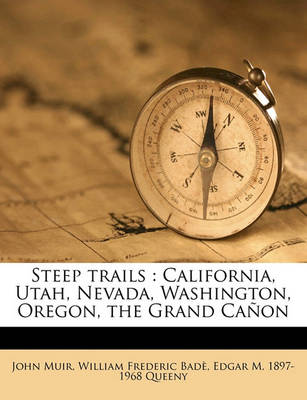Wilderness
2 total works
Steep Trails
by John Muir, William Frederic Bad, Edgar M 1897-1968 Queeny, and William Frederic Bade
Published 1 January 1990
No one wrote about nature with more eloquence or passion than John Muir, and this collection of essays, spanning nearly three decades of his work, shows him at his best. These writings about his travels to the lakes, canyons, and mountains of the American West make a fitting addition to the John Muir Library Series, our ongoing program to reissue the complete works of the first great conservationist author. The two dozen magazine articles and letters in this collection present the natural treasures of an unspoiled land as white settlers found them a century ago: the Great Salt Lake, the San Gabriel Mountains, Mount Rainer, the Grand Canyon.Here are Muir's accounts of a "perilous night" caught in a snowstorm on the summit of Mount Shasta; his rapture at sailing through Puget Sound and seeing the forests of Washington (as well as his ire, describing the proliferating lumber mills, at "this fierce storm of steel that is devouring our forest"); "A Geologist's Winter Walk" in Yosemite, where he found a "living glacier" with which to prove his controversial theory that glacial erosion had formed Yosemite Valley; "the feathered people" - golden eagles, ospreys, hawks, jays, hummingbirds, and others - "sailing the sky and enlivening the rocks and bushes through all the (Grand Canyon) wilderness"; and much more.
Filled with Muir's characteristic boldness and emotion, these stirring essays will appeal to his loyal readers today, just as they did a century ago.
Filled with Muir's characteristic boldness and emotion, these stirring essays will appeal to his loyal readers today, just as they did a century ago.
Our National Parks is a guidebook supreme, an exciting introduction to Yosemite and several other magnificent parks by the man who, more than any other person, helped to create them. After this fast-paced trip with Muir, past visitors to the parks will want to revisit them with new insights, and those who have never wandered these trails will not rest until they have done so.
The book, long out of print, was originally published in 1901, its ten essays having previously appeared as articles in the Atlantic Monthly. Muir wrote them with a single purpose-to entice people, by his descriptions, to come to the parks, to see and enjoy them. If enough people did so, reasoned Muir, they would surely love the wilderness as he did, and the parks would be preserved.
Muir carried out his public relations mission with remarkable success. Every page of this book carries his unbridled and irresistible enthusiasm. Our National Parks is part reminiscence, part philosophy, and mostly enticing description. It is all vintage Muir.
Although the book treats Yellowstone, Sequoia, General Grant, and other national parks of the Western U.S., Muir devotes the bulk of the work to his first love-Yosemite, settled into the heart of the Sierra Nevada. Indeed, six of the book's chapters are devoted to Yosemite, treating the forests, wild gardens, fountains and streams, animals, and birds of the park. The concluding essay is an impassioned plea to save American forests.
All visitors to the great western national parks-and all who will one day visit them-will be captivated by Muir's descriptions. The grandeur of this wilderness is reflected in the very spirit of John Muir. Both shine through every page of this remarkable book.
The book, long out of print, was originally published in 1901, its ten essays having previously appeared as articles in the Atlantic Monthly. Muir wrote them with a single purpose-to entice people, by his descriptions, to come to the parks, to see and enjoy them. If enough people did so, reasoned Muir, they would surely love the wilderness as he did, and the parks would be preserved.
Muir carried out his public relations mission with remarkable success. Every page of this book carries his unbridled and irresistible enthusiasm. Our National Parks is part reminiscence, part philosophy, and mostly enticing description. It is all vintage Muir.
Although the book treats Yellowstone, Sequoia, General Grant, and other national parks of the Western U.S., Muir devotes the bulk of the work to his first love-Yosemite, settled into the heart of the Sierra Nevada. Indeed, six of the book's chapters are devoted to Yosemite, treating the forests, wild gardens, fountains and streams, animals, and birds of the park. The concluding essay is an impassioned plea to save American forests.
All visitors to the great western national parks-and all who will one day visit them-will be captivated by Muir's descriptions. The grandeur of this wilderness is reflected in the very spirit of John Muir. Both shine through every page of this remarkable book.

